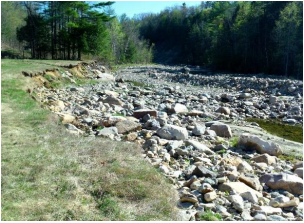Three years ago Lake Champlain reached record highs and Tropical Storm Irene ravaged the northeast. These and more recent flood events demonstrated the importance of buffers, floodplains, and stable riverbanks and shorelines in reducing sediment and pollution flows to the lake. LCC's new publication "Lessons from the Floods" provides guidance on how communities can manage floodplains and shorelines to protect people, property, and waterways. One theme that came up over and over was how bermed rivers failed to contain floods and in many cases exacerbated the damage done by floodwaters.
Berms are earthen walls along the edge of rivers that are meant to keep the river from flowing into the adjacent flood plain. The idea is that the water can rise without reaching the top of the berm. However, during flooding events, erosion can create a more significant hazard than inundation. Fast moving water waters erode away the berms or breaks through upstream. The river then gets trapped on the wrong side of the berm increasing the amount of damage that can occur. Learn more about how Berms create a false sense of security.
